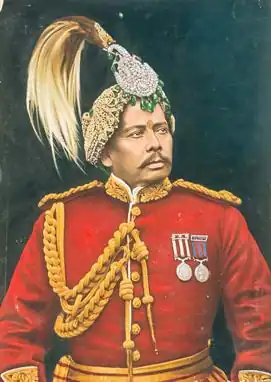Rana Crown
| Rana Crown | |
|---|---|
.jpg) Gem-set Turban Crown of a Rana Prime Minister, Nepal, circa 1900 | |
| Details | |
| Country | Nepal |
| Made | circa 1900 |
| Owner | Private Collection, Japan[1] |
| Weight | Varies by type; generally 18–25 |
| Arches | Six ribs leading to a central emerald |
| Material | Cloth, gold brocade, silver |
| Cap | Pearl-encrusted gold brocade |
| Notable stones | Pearls, diamonds, emeralds, rubies, coloured glass |
| Other elements | Bird-of-paradise feathers; silver badge with Devanagari inscription and Nepalese coat of arms |
| Predecessors | Shripech |
| Successors | None |
The Rana Crown (also known as the Gem-set Turban Crown) is a ceremonial headpiece from Nepal, produced in the early 20th century. It was worn by members of the Rana dynasty, who held hereditary positions as prime ministers during the Rana regime (1846–1951). The crown incorporates local materials and craftsmanship along with external stylistic influences. It served as a formal emblem of political office and high status within the governance structure of the period.
Description

The crown is made from cloth, pearls, precious stones, and gold brocade. It features six structural ribs converging under a central emerald, and a plume of bird-of-paradise feathers. A silver badge at the front bears the Nepalese coat of arms and a national motto in Devanagari script.[2][3]
Role in Rana rule
The crown's design is linked to Jung Bahadur Rana Shree Tin Maharaj,[4] who established the Rana autocracy in 1846. Such headgear served to differentiate ranks within the aristocracy. Use of imported feathers and elaborate ornamentation reflected the wearer’s political stature.[5][6][7][8]
Exhibitions and provenance
The crown was held in a Japanese private collection and auctioned at Christie's in 2019. It has been exhibited at:
- Metropolitan Museum of Art (2014–2015)
- Miho Museum, Japan (2016)
- Grand Palais, Paris (2017)
- Legion of Honor Museum, San Francisco (2018–2019)[9]
See also
External links
References
- ^ Christie's, Lot 142, "A GEM SET TURBAN CROWN," London, 24 October 2019.
- ^ "A GEM SET TURBAN CROWN, Nepal, circa 1900". Christie's. Retrieved 30 July 2025.
- ^ "NepalRoyalArms". www.hubert-herald.nl. Retrieved 2025-07-30.
- ^ "Jung Bahadur | Prime Minister of Nepal & Founder of Rana Dynasty | Britannica". www.britannica.com. 2025-06-14. Retrieved 2025-07-31.
- ^ Dixit, Kunda (2020-09-05). "Inside story of Nepal's Rana dynasty". nepalitimes.com. Retrieved 2025-07-30.
- ^ Acharya, Anup (2024). "Power, Legitimacy, and Identity: A Study of the Rana Crown". NSS Research Journal. 4 (1): 50–59. Retrieved 30 July 2025.
- ^ Truong, Alain. "An impressive gem-set Crown made for the Nepalese Royal Family - India, 19th Century". Alain.R.Truong (in French). Retrieved 2025-07-30.
- ^ "Nepal king's crown auctioned in Bond Street?". India Today. 2008-06-07. Retrieved 2025-07-30.
- ^ "Bonhams : An impressive gem-set Crown made for the Nepalese Royal Family India, 19th Century". www.bonhams.com. Retrieved 2025-07-30.